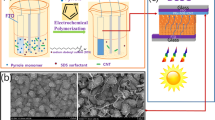Abstract
N-cetylpyridinium iodide (N-CPI) as a new electric additive for enhancing photovoltaic performance of the dye-sensitized solar cell (DSSC) was studied. It showed high efficiency for enhancing both the open-circuit voltage and the short-circuit current density of DSSC when the suitable amount of N-CPI as 0.02 M was added in liquid electrolyte. The energy conversion efficiency of DSSC increased from 4.429% to 6.535%, with 47.55% enhancement. Therefore, it is a highly efficient electric additive for DSSC. The intrinsic reason is owing to the special molecular structure of N-CPI, which contains two different polarity groups. As a surfactant, N-CPI could form ordered arrangement in liquid electrolyte, which affects the diffusing ability and the redox reaction of I−/I −3 , and further affects the photovoltaic performance of DSSC.
Similar content being viewed by others
References
Hagffeldt A, Gratezel M. Light-induced redox reactions in nanocrystalline systems. Chem Rev, 1995, 95: 49–68
Goetzberger A, Luther J, Willeke G. Solar cells: past, present, future. Sol Energy Mater Sol Cells, 2002, 74: 1–11
Green MA. Recent developments in photovoltaics. Sol Energy, 2004, 76: 3–8
Gratzel M. Conversion of sunlight to electric power by nanocrystalline dye-sensitized solar cell. J Photoch Photobio A: Chem, 2004, 164: 3–14
Barbe CJ, Arendse F, Comte P, Gratzel M. Nanocrystalline titanium oxide electrodes for photovoltaic applications. J Am Ceram Soc, 1997, 80: 3157–3171
Kay A, Gratzel M. Dye-sensitized core-shell nanocrystals: impro efficiency of meso porous tin oxide electrodes coated with a thin layer of an insulating oxide. Chem Mater, 2002, 14: 2930–2935
Wang ZS, Huang CH, Huang YY, Hou YJ, Xie PH, Zhang BW, Cheng HM. A highly efficient solar cell made from a dye-modified ZnO-covered TiO2 nanoporous electrode. Chem Mater, 2001, 13: 678–682
Nazeetuddin MK, M. Gratzel M. Conversion of light to electricity by cis-X2 bis(2,2′-bipyridyl-4,4′-dicarboxylate) ruthenium(II) chargetransfer sensitizers (X = Cl−, Br−, I−, CN− and SCN−) on nano crystalline titanium dioxide electrodes. J Am Chem Soc, 1993, 115: 6382–6390
Tamotsu H, Hidetoshi M, Kouichi S, Satoshi U. High efficiency of dye-sensitized solar cells based on metal-free indoline dyes. J Am Chem Soc, 2004, 126: 12218–12219
O’Regan B, Gratzel M. A low-cost high-efficiency solar cell based on dye-sensitized colloidal TiO2 films. Nature, 1991, 353: 737–740
Sapp SA, Elliott C, Contado C. Substituted polypyridine complexes of Cobalt(II/III) as efficient electron-transfer mediators in dye-sensitized solar cells. J Am Chem Soc, 2004, 124: 11215–11222
Nusbaumer H, Moser JE, Zakeeruddin SM. CoII (dbbip) 2+2 complex rivals tri-iodide/iodide redox mediator in dye-sensitized photovoltaic cell. J Phys Chem B, 2001, 105: 10461–10464
Wang P, Zakeeruddin SM, Moser JE, Baker RH, Gratzel M. A solvent-free, SeCN−/(SeCN) −3 based ionic liquid electrolyte for highefficiency dye-sensitized nanocrystalline solar cells. J Am Chem Soc, 2004, 126: 7164–7165
Kusama H, Arakawa H. Influence of alkylaminopyridine additives in electrolytes on dye-sensitized solar cell performance. Sol Energy Mater Sol Cells, 2004, 81: 87–99
Kusama H, Kurashige M, Arakawa H. Influence of nitrogen-containing heterocyclic additives in I−/I −3 redox electrolytic solution on the performance of Ru-dye-sensitized nanocrystalline TiO2 solar cell. J Photoch Photobio A: Chem, 2005, 169: 169–176
Boschloo G, Haggman L, Hagfeldt A. Quantification of the effect of 4-tert-butylpyridine addition to I−/I −3 redox electrolytes in dye-sensitized nanostructured TiO2 solar cells. J Phys Chem B, 2006, 110: 110: 13144–13150
Wu JH, Lan Z, Lin JM, Huang ML, Li PJ. Effect of solvents in liquid electrolyte on the photovoltaic performance of dye-sensitized solar cells. J Power Sources, 2007, 173: 585–591
Kambe S, Nakade S, Kitamura T, Wada Y, Yanagida S. Influence of the electrolytes on electron transport in mesoporous TiO2-electrolyte systems. J Phys Chem B, 2002, 106: 2967–2972
Wu JH, Lan Z, Wang DB, Hao SC, Lin JM, Huang YF, Yin S, Tsugio S. Gel polymer electrolyte based on poly(acrylonitrile-co-styrene) and a novel organic iodide salt for quasi-solid state dye-sensitized solar cell. Electrochim Acta, 2006, 51: 4243–4249
Popov AI, Geske DH. Studies on the chemistry of halogen and of polyhalides. XIII. Voltammetry of iodine species in acetonitrile. J Am Chem Soc, 1958, 80: 1340–1352
Wei TC, Wan CC, Wang YY, Chen CM, Shiu HS. Immobilization of poly(N-vinyl-2-pyrrolidone)-capped platinum nanoclusters on indium-tin oxide glass and its application in dye-sensitized solar cells. J Phys Chem C, 2007, 111: 4847–4853
Hauch A, Georg A. Diffusion in the electrolyte and charge-transfer reaction at the platinum electrode in dye-sensitized solar cells. Electrochim Acta, 2001, 46: 3457–3466
Wang P, Zakeeruddin SM, Comte P, Exnar I, Gratzel M. Gelation of ionic liquid-based electrolytes with silica nanoparticles for quasisolid-state dye-sensitized solar cells. J Am Chem Soc, 2003, 125: 1166–1167
Kalyanasundaram K, Gratzel M. Applications of functionalized transition metal complexes in photonic and optoelectronic devices. Coord Chem Rev, 1998, 177: 347–414
Murakami TN, Gratzel M. Counter electrodes for DSC: application of functional materials as catalysts. Inorg Chim Acta, 2008, 361: 572–580
Zhang ZP, Zakeeruddin SM, O’Regan BC, Baker RH, Gratzel M. Influence of 4-guanidinobutyric acid as coadsorbent in reducing recombination in dye-sensitized solar cells. J Phys Chem B, 2005, 109: 21818–21824
Author information
Authors and Affiliations
Corresponding authors
Rights and permissions
About this article
Cite this article
Lan, Z., Wu, J., Lin, J. et al. A highly efficient electric additive for enhancing photovoltaic performance of dye-sensitized solar cells. Sci. China Chem. 53, 1352–1357 (2010). https://doi.org/10.1007/s11426-010-3204-z
Received:
Accepted:
Published:
Issue Date:
DOI: https://doi.org/10.1007/s11426-010-3204-z



